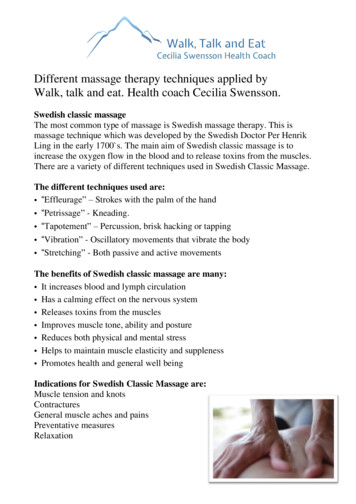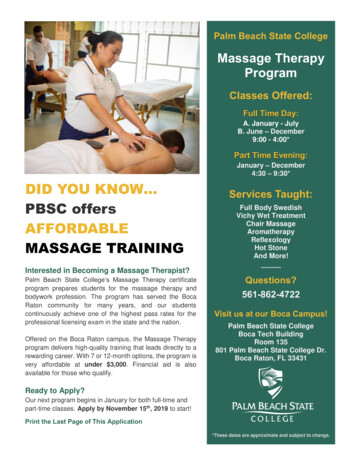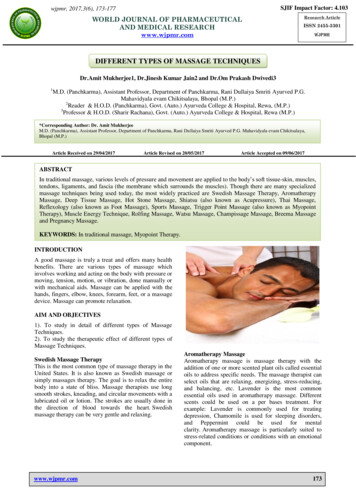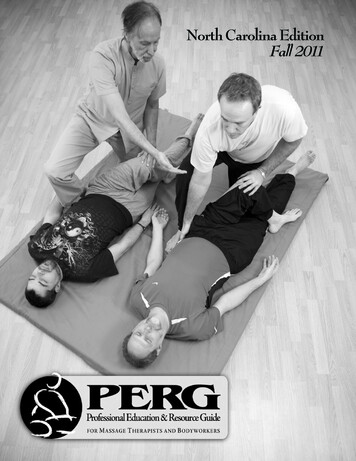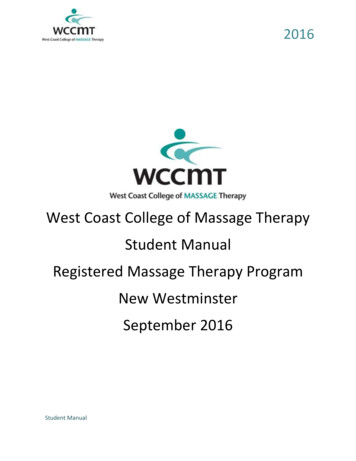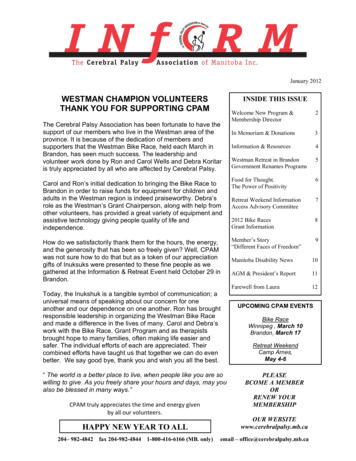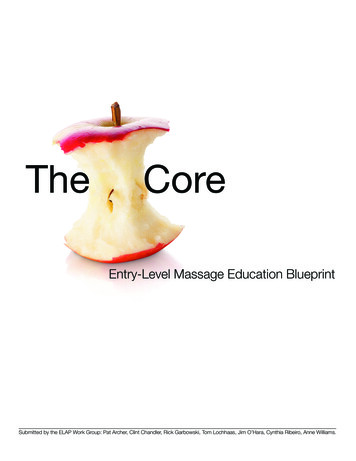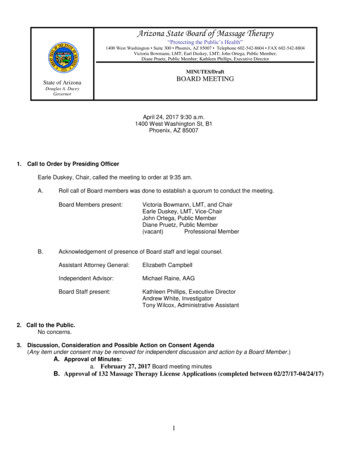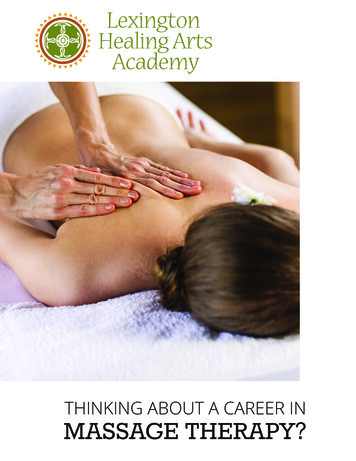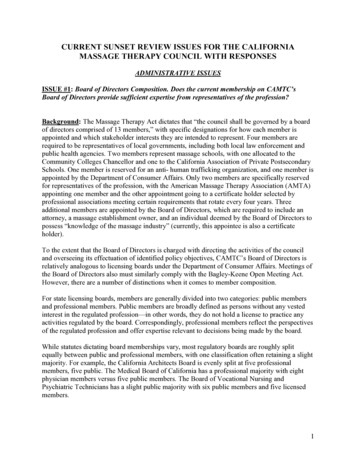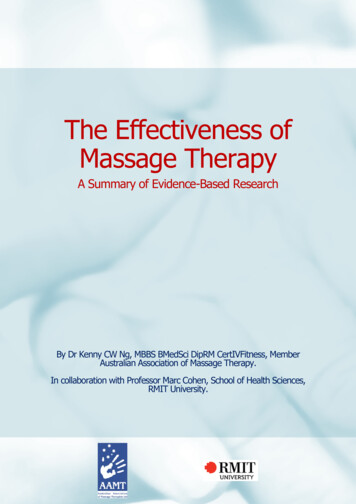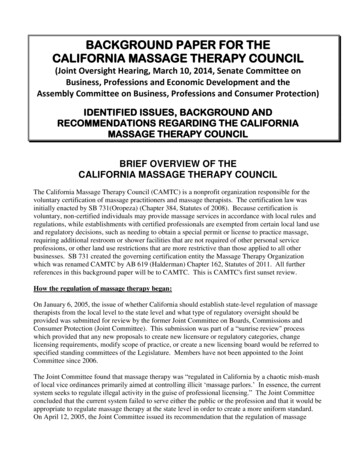
Transcription
BACKGROUND PAPER FOR THECALIFORNIA MASSAGE THERAPY COUNCIL(Joint Oversight Hearing, March 10, 2014, Senate Committee onBusiness, Professions and Economic Development and theAssembly Committee on Business, Professions and Consumer Protection)IDENTIFIED ISSUES, BACKGROUND ANDRECOMMENDATIONS REGARDING THE CALIFORNIAMASSAGE THERAPY COUNCILBRIEF OVERVIEW OF THECALIFORNIA MASSAGE THERAPY COUNCILThe California Massage Therapy Council (CAMTC) is a nonprofit organization responsible for thevoluntary certification of massage practitioners and massage therapists. The certification law wasinitially enacted by SB 731(Oropeza) (Chapter 384, Statutes of 2008). Because certification isvoluntary, non-certified individuals may provide massage services in accordance with local rules andregulations, while establishments with certified professionals are exempted from certain local land useand regulatory decisions, such as needing to obtain a special permit or license to practice massage,requiring additional restroom or shower facilities that are not required of other personal serviceprofessions, or other land use restrictions that are more restrictive than those applied to all otherbusinesses. SB 731 created the governing certification entity the Massage Therapy Organizationwhich was renamed CAMTC by AB 619 (Halderman) Chapter 162, Statutes of 2011. All furtherreferences in this background paper will be to CAMTC. This is CAMTC's first sunset review.How the regulation of massage therapy began:On January 6, 2005, the issue of whether California should establish state-level regulation of massagetherapists from the local level to the state level and what type of regulatory oversight should beprovided was submitted for review by the former Joint Committee on Boards, Commissions andConsumer Protection (Joint Committee). This submission was part of a “sunrise review" processwhich provided that any new proposals to create new licensure or regulatory categories, changelicensing requirements, modify scope of practice, or create a new licensing board would be referred tospecified standing committees of the Legislature. Members have not been appointed to the JointCommittee since 2006.The Joint Committee found that massage therapy was “regulated in California by a chaotic mish-mashof local vice ordinances primarily aimed at controlling illicit ‘massage parlors.’ In essence, the currentsystem seeks to regulate illegal activity in the guise of professional licensing.” The Joint Committeeconcluded that the current system failed to serve either the public or the profession and that it would beappropriate to regulate massage therapy at the state level in order to create a more uniform standard.On April 12, 2005, the Joint Committee issued its recommendation that the regulation of massage
therapists should be shifted from local jurisdictions to a state-based approach.The recommended regulatory regime for massage therapy was modeled after regulatory regimes for taxpreparers (Business and Professions Code (BPC) Section 22250, et seq.) and interior designers (BPC5800 et seq.) which provide for statutorily created non-profit corporations that have the authority tocertify qualified individuals in their respective professions. The reasoning for selecting this model overanother model, such as the more traditional board or bureau, is not known.The Role of CAMTC:The Massage Therapy Act implements a voluntary title act rather than a mandatory practice act. Thereis an important distinction between regulations which require licensure and those which protect aprofessional title. Statutes regulating professions in California generally fall into two categories: a"practice act," or a "title act." A “practice act" regulates the duties, responsibilities and scope ofpractice that a licensee can perform upon meeting specific educational, experiential or trainingrequirements. A “title act" simply regulates the use of the title an individual may use in practice. Inorder to be permitted to use a title, a state may require proof that an individual has a certain level ofexperience or education relevant to the particular title being regulated.BPC 4606 makes it an unfair business practice for a person to use the term “certified massagepractitioner” or “certified massage therapist” or any other term, such as “licensed,” “registered,”“CMP,” or “CMT,” that implies or suggests that the person is certified as a massage therapist orpractitioner without being certified by CAMTC.CAMTC-certified professionals are recognized throughout California to provide massage services butmay still be subject to certain local ordinances and business regulations. Current law permits cities orcounties to adopt local ordinances regarding inspection authority, reasonable health and safetystandards, and background checks for owners and operators owning 5% or more of a business. Forindividuals who are not certified by CAMTC, local jurisdictions may regulate those businesses as theywish. The law also authorizes CAMTC to deny applications and discipline certificate holders byrevoking or suspending an individual's certificate.CAMTC is currently comprised of nineteen board members (Board) who are appointed by variousentities including massage trade associations, massage schools, individual bodywork and massageprofessionals, the League of California Cities, the Department of Consumer Affairs (DCA), theCalifornia State Association of Counties, the Association of Private Sector Colleges and Universities,the California Association of Private Postsecondary Schools and the Board itself. Currently, CAMTChas one Board member vacancy.CAMTC's objective is to "protect the health and safety of California consumers by promoting andenforcing laws and protocols that serve the public and certified massage professionals."CAMTC's bylaws state that "the specific purpose of the corporation is to provide certification formassage therapists and to advance public education regarding the massage therapy profession inCalifornia as a quasi-public body pursuant to the authority granted in the Code for the benefit of thepublic."2
CAMTC's mission statement is:To protect the public by certifying qualified massage professionals in California.CAMTC is a private 501(c)(3) nonprofit corporation and currently does not receive any monies fromthe State. BPC 4600.5 provides for the certification program to be administered by CAMTC; howeverexisting law does not provide for start-up funding, legal support or administration of the program.According to CAMTC, its genesis began when representatives of the California Chapter of theAmerican Massage Therapy Association (AMTA-CA) and Associated Bodywork and MassageProfessionals (ABMP) began meeting in October 2008, to establish the “Massage TherapyOrganization.” The legislative advocates for these two associations provided the initial advisorysupport in order to form the organization.Although the establishment of CAMTC and the laws pertaining to the voluntary certification ofmassage therapy is less than five years old, there have been numerous legislative changes pertaining tothe certification process, the composition of the CAMTC Board, and the general role of CAMTC.California legislation pertaining to CAMTC and the certification of massage professionals are asfollows:SB 294 (Negrete-McLeod) Chapter 695, Statutes of 2010, changed the sunset dates on variousboards, bureaus, and program within the DCA, including CAMTC, from 2016 to 2015.SB 285 (Correa) Chapter 149, Statutes of 2011, made it a misdemeanor to provide a certificate,diploma or other document, or otherwise affirm a person has received instruction in massagetherapy, knowing the person has not received training "consistent with that document oraffirmation" and provided that when a person is prosecuted for a crime in connection with massagetherapy, including crimes relating to prostitution, the arresting law enforcement agency mayprovide information to CAMTC concerning the person's massage therapy training, including thename of any school attended by the person.AB 619 (Halderman) Chapter 162, Statutes of 2011, changed the name of the governing entityfrom MTO to CAMTC and made a number of clarifying, conforming and technical changes to theMassage Therapy Act regarding the approval of schools, reimbursement of costs incurred byCAMTC for denying a massage certificate or disciplining a certificate holder, the advertising anddisplay of the massage certificate, and the granting of a conditional certificate.SB 1238 (Price) Chapter 655, Statutes of 2012, made a number of substantive, clarifying,conforming and technical changes to the Massage Therapy Act regarding the approval of schoolcredit hours and the examination and training requirements for purposes of certification; thegrounds for suspension, denial or revocation of certification of the certificate holder; the sharing ofinformation between local law enforcement and CAMTC; the responsibility of owner/operators ofmassage businesses for conduct of employees or their independent contractors and backgroundchecks of owner/operators; and, the ability for cities to restrict the operation of massage businessesinvolved in prior criminal activity.AB 1147 (Gomez) of 2013 in its current form seeks to revise the qualifications for a certifiedmassage practitioner by requiring applicants to pass a massage and bodywork competency3
examination. This bill is currently pending in the Senate Business, Professions and EconomicDevelopment Committee.CAMTC’s authorizing statute called for the program to be administered by a nonprofit organizationwhich did not exist at the time the law was enacted. The only mandate for the organization was that itneeded to be a tax exempt organization under section 501(c)(3) of the Internal Revenue Code.History of the certification process:CAMTC currently certifies both massage practitioners and massage therapists. Up until January 1,2012, CAMTC also offered a Conditional Certified Massage Practitioner certification. According toCAMTC, the first certifications were issued on September 15, 2009. CAMTC states that it processed10,835 applications throughout 2009, the first year the law took effect. CAMTC subsequentlyprocessed 13,468 applications in 2010, 13,842 in 2011, and 10,792 in 2012. As reported in its SunsetReview Report 2013, CAMTC received an average of 200 new applications per week throughSeptember of 2013, and projected to process approximately 10,400 new applications by the end of2013.Certificates for Massage Practitioners and Massage Therapists are valid for two years, at which timecertificate holders are required to apply for recertification. According to CAMTC, in September of2011, the recertification process began for those massage professionals certified in 2009. CAMTCprocessed 2,403 recertification applications in 2011 and 10,962 in 2012. According to CAMTC'sSunset Review Report 2013, CAMTC projected the number of applications for recertification to be inexcess of 7,000 for 2013.CAMTC reports that since August of 2009, it has processed more than 80,000 new and recertificationapplications and oversees approximately 43,000 active certified massage professionals. At this time,CAMTC does not certify or regulate massage businesses, establishments or business owners, otherthan sole proprietors who obtain certification to practice.In total, CAMTC states that it has certified more than 7,600 Certified Massage Practitioners, 35,000Certified Massage Therapists, and 2,94 Conditional Certified Massage Practitioners. Each level ofcertification has specific education and testing requirements.Certified Massage Therapists are required to obtain at least 500 hours of massage education. Aminimum of 250 hours must be from approved schools, and the remaining 250 hours may be securedeither from approved schools, or from continuing education providers. Presently, CAMTC acceptscontinuing education from providers approved by DCA or the National Certification Board forTherapeutic Massage & Bodywork (NCBTMB). CAMTC retains the right to review the legitimacyand relevance of continuing education courses. An alternate pathway to become a Certified MassageTherapist requires applicants to have at least 250 hours of massage education, which shall not beonline or distance learning and must include 100 hours in specified curriculum subjects and passage ofan approved examination.Certified Massage Practitioners must have at least 250 hours of massage education, including 100hours in anatomy and physiology, contraindications, health and hygiene, and business and ethics. Theeducation must be obtained at an approved school, and may not be online or distance learning.4
CAMTC also offered a Conditional Certified Massage Practitioner (CCMP) certificate for an applicantwho had not completed the required 250 hours of education. A CCMP designee is required to provideevidence of completing a minimum of 30 hours of continuing massage education each year, whichcannot be online or distance learning, until the massage education totals 250 hours. Once an applicanthas completed a minimum of 250 hours of massage education, the applicant may be eligible to applyfor certification as a massage practitioner. Originally designed as a form of "grandfathering" toinclude experienced professionals already in practice, CCMP certification was no longer available asof January 2, 2012. However, for current CCMP certificate holders, recertification applications andthe completion of the specified educational requirements will continue to be accepted until December31, 2016.In 2009, the Board approved the use of the National Certification Exam for Therapeutic Massage andBodywork (NCETMB); the National Certification Exam for Therapeutic Massage (NCETM); and, theMassage and Bodywork Licensing Exam (MBLEx). CAMTC may accept the passage of one of theapproved examinations as a means to verify education from schools that have closed or as additionalproof of adequate education. CAMTC reports that 43 states, the District of Columbia and Puerto Ricorequire at least one of the above examinations.The Massage Industry:Massage professionals treat clients by using touch to manipulate the soft-tissue and muscles of thebody. Massage therapy may be used to relieve pain, rehabilitate injuries, reduce stress, increaserelaxation, and enhance the general wellness of clients. Massage professionals work in a variety ofsettings, including private offices, spas, hospitals, fitness centers and shopping malls.The American Massage Therapy Association's 17th annual consumer survey from October 2013reported that 75% of a random sample of individuals surveyed claim their primary reason for receivinga massage in the past 12 months was medical (43%) or stress (32%) related. Medical reasons includepain relief, soreness, stiffness or spasms, injury recovery, migraines, prevention, and general wellbeing. It reported that 88% of respondents viewed massage as beneficial to overall health and wellnessand believe massage can be effective in reducing pain, with 24% saying that they have used massagetherapy for pain relief.According to the Bureau of Labor Statistics, employment of massage professionals nationwide isprojected to grow 23% from 2012 to 2022, which is much faster than the average growth for alloccupations. According to the survey fact sheet, more people are turning to massage therapy to assistwith medical conditions. The survey reported 56% of people received a massage for one or more ofthe following reasons: soreness, stiffness or spasms, to relieve or manage stress, for prevention or toimprove quality of life, injury recovery or rehabilitation, to keep fit or healthy/ maintain wellness, or tocontrol headaches or migraines. Additionally, 39% indicated that medical benefits would be theirprimary motivation for having a massage.As of March of 2013, 44 states regulate massage therapy at the state level. 40 states require licensurefor massage therapy professionals and four states (California, Colorado, Indiana and Virginia) requirea certification or registration. Of those 44 states with regulatory requirements, 30 have had stateoversight for over 15 years. As of March 2013, six additional states have introduced or draftedlegislation to regulate massage therapy professionals. State requirements for licensure and certificationvary based on hours of education, continuing education and the requirement of an examination. For5
example, New York requires 1000 hours of education, 36 hours of continuing education every threeyears and the passage of a state examination; Nevada requires 500 hours of education, 12 hours ofcontinuing education annually, and the passage of a specified national examination; and Arizonarequires 700 hours of education, 25 hours of continuing education every two years and the passage of aspecified national examination.It should be noted that this Background Paper avoids use of the term "massage parlor," which isviewed by the massage profession as a dated and pejorative term suggesting a place associated withprostitution. The more appropriate term used here to describe a place where the profession of massagetherapy is practiced is a massage business or massage establishment.Board Membership and Committees:The initial Board consisted of 11 members and was later expanded to 20 members in 2009. The Boardcurrently has 19 members.CAMTC’s bylaws allow for a maximum of 20 Board members, but no less than four. Currently, sevenBoard members are designated certified massage professionals. Eight Board members arerepresentatives selected by four different professional associations. Three Board members arerepresentatives selected by statewide associations of private postsecondary schools. One Boardmember is a representative selected by the League of California Cities, one Board member is arepresentative selected by the California State Association of Counties, and one Board member is arepresentative selected by the Director of DCA. The remaining six Board members are appointed by atwo-thirds vote of the Board pursuant to CAMTC’s bylaws.The following is a listing of the current Board members and their background as provided directly tothe Committees by 200911/19/2015AppointmentDateName and Short BioMark W. Dixon, CMT ChairMark Dixon, of Huntington Beach, is a past member of thenational board of the American Massage Therapy Association(AMTA). He served on the Board of the National CertificationBoard for Therapeutic Massage & Bodywork (NCBTMB) wherehe chaired the Governmental Relations Panel. As a sportsmassage therapist he has served since 1992 as the LA MarathonSports Massage Team Supervisor, was on the Olympic GamesSports Massage Teams in Atlanta (1996), Salt Lake City (2002)and Athens (2004) as well as being a member of the SportsMedicine Team of the US Olympic Committee, Colorado SpringsNational Training Center. He currently has a private therapeuticmassage practice in Newport Beach.Keith Eric Grant PhD. Vice ChairKeith Eric Grant, of Pleasanton, holds a BS in Physics (San JoseState University) and a PhD in Applied Science (UC Davis). ociation of
was employed at Lawrence Livermore National Laboratory from1972 into 2008. He currently focuses on science writing,particularly in atmospheric science and mathematical biology. Dr.Grant has taught massage at the McKinnon Institute in Oaklandfrom 1992 to present. He was an invited educator at theformation meetings of the Federation of State Massage TherapyBoards (FSMTB) in 2005 and has worked on committees for boththe Massage Therapy Foundation and FSMTB.Robert Rolnick, CMT, LMT (HI) SecretaryRoberta Rolnick is an experienced management professional inthe luxury hospitality industry. She has managed spas in leadingresorts such as the Mandalay Bay Resort & Casino, Las VegasNV, Ojai Valley Inn & Spa, Ojai, CA and The Royal KonaResort, Kona, HI, to name a few. Currently she is the owner ofSPA 1805 Massage & Wellness, Bakersfield. Ms. Rolnick is anactive member of the American Massage Therapy Association –California Chapter and of Associated Bodywork & MassageProfessionals.Michael Marylander, ael Marylander is founder and president of The MassagePlace, Inc., a chain of 13 company-owned and licensed massagetherapy centers. Mr. Marylander is on the Advisory Board of theAssociated Bodywork and Massage Professionals and is a guestlecturer at UEI (United Education Institute) and Santa MonicaSchool of Massage.William ArmourBill Armour is currently President of Burke Williams Inc. aleading California company in the spa & massage industry. Afterseveral successful business start–ups, he founded Burke Williamsin 1986. The company began with a single location in West LosAngeles and has grown to nine locations throughout the stateemploying over 900 CAMTC Certified Massage Therapists andover 1500 employees overall.Mike Callagy, J.D., MPAMike Callagy is the Deputy County Manager in San MateoCounty. His responsibilities include coordinating Public SafetyRealignment efforts in the County and organizing all criminaljustice activities throughout the various county departments andlaw enforcement agencies. Mr. Callagy recently retired as theDeputy Chief of Police for the City of San Mateo after almost a30 year career in Law Enforcement. As a leader in lawenforcement, retired Chief Callagy represented the League ofCities and the California Police Chiefs Association on theCAMTC Board. Mr. Callagy graduated from the highlyacclaimed P.O.S.T Command College and FBI NationalAcademy. Mr. Callagy is a licensed attorney in the State ofCalifornia and has a Masters' Degree in Public Administration7
from the University of Notre Dame de Namur and a Masters'Degree in Homeland Defense and Security from the NavalPostgraduate School.Judi Calvert, LMT01/14/201001/14/2016Hands /2015CaliforniaStateAssociation 3/201302/19/2015League ofCaliforniaCitiesJudi Calvert, of Spokane, Washington, has a long career as amassage therapist. In 1985 she co-founded and publishedMassage Magazine until 2005. Ms. Calvert is also the co-founderand curator of the World of Massage Museum. She is Presidentof Hands on Trade Association.Ben DrillingsBen Drillings, D.C., of Chatsworth, is the founder and director ofBen Drillings Chiropractic and of A2ZHealth.net vocationalschools of therapeutic massage. As Director of A2Z Health Expohe has organized eight professional conferences. Dr. Drillingsstudied exercise physiology at Long Island University andreceived his Doctor of Chiropractic degree at New YorkChiropractic College, with a B.S. from Regent College in NewYork.Guy Fuson, MPAGuy Fuson is the tax and License Manager for the SacramentoCounty Department of Finance. Mr. Fuson oversees theSacramento County business license process, regulatingbusinesses operating in the unincorporated areas of the County.He was one of the key people in the County’s modernization oftheir massage ordinance in 2004. Mr. Fuson is a former CityCouncilman and Planning Commissioner for the Town of Loomisand holds a Master’s degree in Public Policy and PublicAdministration.Elna Leonardo CMT, CPAElna Leonardo was a former Project Manager & ComputerSecurity Consultant with PricewaterhouseCoopers who venturedinto Healing Arts as a Bodywork/Massage Therapist. She foundfulfillment serving a range of capacities from enhancing corporatesecurity systems to empowering individual healing. Whileactualizing this ‘High Tech to High Touch’ career move, Ms.Leonardo has re-entered the world of Information Technology inanother supportive role by way of setting up and maintainingSocial Media platforms. Currently her involvement in themassage profession is as a member of the CAMTC board and theAudit committee.Chief Arthur MillerArthur J. Miller is the Chief of Police for South Pasadena. He hada 35-year career with the Los Angeles Police Department (LAPD)8
retiring as a Captain that oversaw Special Weapons and Tactics(SWAT), Horse Mounted Unit, K-9, Underwater Dive Team,VIP/Dignitary Security and City-wide Crime Suppression Units.He is the only recipient of all three of LAPD’s highest awards forbravery. Chief Miller has a Bachelor’s in BusinessAdministration and a Masters' Degree in OrganizationalLeadership. He is a graduate of the FBI National Academy andthe United States Army West Point Leadership as well asnumerous specialized training courses presented by the CaliforniaCommission on Peace Officer Standards and Training (POST).Chris Christian Pezza, CMP02/15/201201/14/2016Hands atedBodywork ssociatedBodywork an Pezza is the executive director of a non-profit educationfoundation that operated two massage schools in SouthernCalifornia. He is the owner of the Tao Healing Arts Center, anintegrative holistic clinic that has been serving the community inSanta Monica since 1981.Jean RobinsonJean Robinson, of Denver, has served as the national governmentrelations director for ABMP, since 2006. She collaborates withpolicy makers at all levels of government to inform theconversation surrounding legislative and regulatory issuesimpacting the profession and advocates for consistent andappropriate regulation based on data, research, and a healthy doseof common sense. Prior to her employment with ABMP, Ms.Robinson was a health care policy analyst and communityorganizer.Marcy SchaubeckMarcy Schaubeck is the owner of five Massage Envy clinics inOrange and Los Angeles Counties. She currently employs over110 CAMTC Certified Massage Therapists. She also owns fourEuropean Wax Centers in Orange County and employs over 40Board of Barbering and Cosmetology licensed estheticians andcosmetologists. Ms. Schaubeck served on the board for thePlacentia Chamber as Vice President. She holds a Bachelors'degree from University of Nevada Las Vegas in CommunicationStudies and worked in the advertising industry prior to becominga business owner.Michael Sinel, M.D.Michael Sinel, M.D. is a nationally recognized expert in thefield of back pain and spinal disorders. He is board certified inPhysical Medicine and Rehabilitation and serves as an AssistantClinical Professor in the UCLA School of Medicine. Dr. Sinelhas authored two books on back pain and several academicarticles. He was a managing partner of a highly successfulambulatory surgery center in Beverly Hills and is a founding9Director ofDCA
partner of Samia Solutions, a National Healthcare AncillaryMarketing and distribution company. Dr. Sinel also serves on theBoard of Directors of the California Coalition to Abolish Slaveryand Trafficking.Joseph Smith, CMT02/11/201002/19/2015CaliforniaAssociation 016AmericanMassageTherapyAssociation –CA eCouncil(AMC)Joseph Smith serves as Strategic Development Director forNational Holistic Institute (NHI), California’s largest and firstaccredited massage therapy college. Utilizing his media, salesmanagement, and massage therapy background, Joe Bobpurchased and turned around his ailing alma mater, eventuallyselling to NHI, where he managed the relocation and expansionof the Los Angeles campus and the creation of the Orange Countybranch, all the while maintaining stellar recruitment, retention,and placement numbers. Joe Bob serves as NHI’s massageindustry liaison.Caroline Tseng, J.D.Caroline Tseng serves as Associate General Counsel of theAmerican Massage Council (AMC). At AMC, she is responsiblefor handling massage malpractice claims as well as overseeingmalpractice claims in litigation from inception to trial. Ms. Tsengreceived her undergraduate degree in Legal Studies fromUniversity of California at Berkeley in 1999 and received herJuris Doctorate from Loyola Law School of Los Angeles in 2005.Deborah Tuck, CMT, BCTMB, LDT1Deborah Tuck is an active member of the massage community,serving in various advisory committees in the public andnonprofit area including Past President of the AMTA-CA SiliconValley Unit, AMTA Delegate for California as well as serving onnumerous others. In her private practice she specializes inOncology and Pain Management, working closely with othermedical professionals. Ms. Tuck has an Associate Degree inMassage Therapy from De Anza Community College inCupertino. She recently retired as Massage Therapy ProgramAssistant to the De Anza Community College Massage TherapyProgram and continues to mentor new therapists. Prior to hercareer in massage, she worked for 20 years for high techcompanies.Dixie Wall, L.Ac, HHPDixie Wall has been a student and practitioner of holistic health,nutrition and Asian Medicine for over ten years. She received herHolistic Health Practitioner certification from the Healing HandsSchool of Holistic Health in 2003, and owned a private massagepractice, Massage Works, Inc. In 2005, she became a contributingeditor for Massage Today, where she followed Californialegislation, and wrote on other Practice Management topics. Ms.10
Wall is a graduate of South Baylo University with a Masters inOriental Medicine and Acupuncture and is currently a CA statelicensed acupuncturist. She was elected and served as a Directorfor the Federation of State Massage Therapy Boards (FSMTB)from 2012-2013 and served on the bylaws committee as well astraining the Board and delegates in Roberts’
Certified Massage Therapists, and 2,94 Conditional Certified Massage Practitioners. Each level of certification has specific education and testing requirements. Certified Massage Therapists are required to obtain at least 500 hours of massage education. A minimum of 250 hours must be from approved schools, and the remaining 250 hours may be secured
